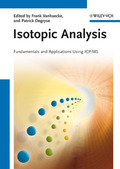Isotopic Analysis
Fundamentals and Applications Using ICP-MS

1. Edition June 2012
XXI, 529 Pages, Hardcover
137 Pictures (3 Colored Figures)
22 tables
Practical Approach Book
Short Description
A practical guide to ICP-MS, providing an overview of the wide range of applications covering everything from geochronological dating to ecotoxicology and biomedical applications.
Buy now
Price: 122,00 €
Price incl. VAT, excl. Shipping
Euro prices for Wiley-VCH and Ernst & Sohn titles are only valid for Germany. In EU countries, local VAT applies. Postage will be charged.
- Out of print -
Edited by two very well-known and respected scientists in the field, this excellent practical guide is the first to cover the fundamentals and a wide range of applications, as well as showing readers how to efficiently use this increasingly important technique.
From the contents:
* The Isotopic Composition of the Elements
* Single-Collector ICP-MS
* Multi-Collector ICP-MS
* Advances in Laser Ablation - Multi-Collector ICP-MS
* Correction for Instrumental Mass Discrimination in Isotope Ratio Determination with Multi-Collector ICP-MS
* Reference Materials in Isotopic Analysis
* Quality Control in Isotope Ratio Applications
* Determination of Trace Elements and Elemental Species Using Isotope Dilution ICP-MS
* Geochronological Dating
* Application of Multi-Collector ICP-MS to Isotopic Analysis in Cosmochemistry
* Establishing the Basis for Using Stable Isotope Ratios of Metals as Paleoredox Proxies
* Isotopes as Tracers of Elements Across the Geosphere-Biosphere Interface
* Archaeometric Applications
* Forensics Applications
* Nuclear Applications
* The Use of Stable Isotope Techniques for Studying Mineral and Trace Element Metabolism in Humans
* Isotopic Analysis via Multi-Collector ICP-MS in Elemental Speciation
A must-have for newcomers as well as established scientists seeking an overview of isotopic analysis via ICP-MS.
THE ISOTOPIC COMPOSITION OF THE ELEMENTS
Atomic Structure
Isotopes
Relation Between Atomic Structure and Natural Abundance of Elements and Isotopes
Natural Isotopic Composition of the Elements
SINGLE-COLLECTOR INDUCTIVELY COUPLED PLASMA MASS SPECTROMETRY
Mass Spectrometry
The Inductively Coupled Plasma Ion Source
Basic Operating Principles of Mass Spectrometers
Quadrupole-Based ICP-MS
Sample Introduction Strategies in ICP-MS
Spectral Interferences
Measuring Isotope Ratios with Single-Collector ICP-MS
MULTI-COLLECTOR INDUCTIVELY COUPLED PLASMA MASS SPECTROMETRY
Introduction
Early Multi-Collector Mass Spectrometers
Variable Multi-Collector Mass Spectrometers
Mass Resolution and Resolving Power
Three-Isotope Plots for Measurement Validation
Detector Technologies for Multi-Collection
Conclusion
ADVANCES IN LASER ABLATION-MULTI-COLLECTOR INDUCTIVELY COUPLED PLASMA MASS SPECTROMETRY
Precision of Isotope Ratio Measurements
Stable Signal Intensity Profiles: Why So Important?
Signal Smoothing Device
Multiple Ion Counting
Isotope Fractionation During Laser Ablation and Ionization
Standardization of the Isotope Ratio Data
CORRECTION OF INSTRUMENTAL MASS DISCRIMINATION FOR ISOTOPE RATIO DETERMINATION WITH MULTI-COLLECTOR INDUCTIVELY COUPLED PLASMA MASS SPECTROMETRY
Historical Introduction
Mass Bias in MC-ICP-MS
Systematics of Mass Bias Correction Models
Logic of Conventional Correction Models
Pitfalls with Some Correction Models
Integrity of the Correction Models
The Regression Model
Calibration with Double Spikes
Calibration with Internal Correction
Uncertainty Evaluation
Conclusion
REFERENCE MATERIALS IN ISOTOPIC ANALYSIS
Introduction
Terminology
Determination of Isotope Amount Ratios
Isotopic Reference Materials
Present Status, Related Problems, and Solutions
Conclusion and Outlook
QUALITY CONTROL IN ISOTOPE RATIO APPLICATIONS
Introduction
Terminology and Definitions
Measurement Uncertainty
Conclusion
DETERMINATION OF TRACE ELEMENTS AND ELEMENTAL SPECIES USING ISOTOPE DILUTION INDUCTIVELY COUPLED PLASMA MASS SPECTROMETRY
Introduction
Fundamentals
Selected Examples of Trace Element Determination via ICP-IDMS
GEOCHRONOLOGICAL DATING
Geochronology: Principles
Practicalities
Various Isotopic Systems
Systems for Which ICP-MS Analysis Brings Fewer Advantages
APPLICATION OF MULTIPLE-COLLECTOR INDUCTIVELY COUPLED PLASMA MASS SPECTROMETRY TO ISOTOPIC ANALYSIS IN COSMOCHEMISTRY
Introduction
Extraterrestrial Samples
Origin of Cosmochemical Isotopic Variations
Use of MC-ICP-MS in Cosmochemistry
Applications of MC-ICP-MS in Cosmochemistry
Conclusion
ESTABLISHING THE BASIS FOR USING STABLE ISOTOPE RATIOS OF METALS AS PALEOREDOX PROCIES
Introduction
Isotope Ratios of Metals as Paleoredox Proxies
Diagenesis: a Critical Area for Further Work
ISOTOPES AS TRACERS OF ELEMENTS ACROSS THE GEOSPHERE-BIOSPHERE INTERFACE
Description of the Geosphere-Biosphere Interface
Elements That Typify the Geosphere-Biosphere Interface
Microbes at the Interface
Element Tracing in Environmental Science and Exploration of Metal Deposits
Isotopes as Indicators of Paleoenvironments
Tracing the Geosphere Effect on Vegetation and Animals
Tracing in the Marine Environment
Future Directions
ARCHEOMETRIC APPLICATIONS
Introduction
Current Applications
New Applications
Conclusion
FORENSIC APPLICATIONS
Introduction
Forensic Applications Based on ICP-MS Isotopic Analysis
Future Outlook
NUCLEAR APPLICATIONS
Introduction
Rationale
Process Control and Monitoring in the Nuclear Industry
Isotopic Studies of the Distribution of U and Pu in the Environment
Nuclear Forensics
Prospects for Future Developments
THE USE OF STABLE ISOTOPE TECHNIQUES FOR STUDYING MINERAL AND TRACE ELEMENT METABOLISM IN HUMANS
Essential Elements
Stable Isotopic Labels Versus Radiotracers
Quantification of Stable Isotopic Tracers
Isotope Labeling Techniques
Concepts of Using Tracers in Studies of Element Metabolism in Humans
ICP-MS in Stable Isotope-Based Metabolic Studies
Element-by-Element Review
ISOTOPIC ANALYSIS VIA MULTI-COLLECTOR INDUCTIVELY COUPLED PLASMA MASS SPECTROMETRY IN ELEMENTAL SPECIATION
Introduction
Advantage of On-Line versus Off-Line Separation of Elemental Species
Coupling Chromatography with MC-ICP-MS
Environmental and Other Applications
Conclusion and Future Trends
Patrick Degryse (°1974) is Professor of Archaeometry at the department of Earth and Environmental Sciences and director of the Centre for Archaeological Sciences at the Katholieke Universiteit Leuven (Belgium). His main research efforts focus on the use of mineral raw materials in ancient ceramic, glass, metal and building stone production, using petrographical, mineralogical and isotope geochemical techniques. He teaches geology, geochemistry, archaeometry and natural sciences in archaeology, and outside the lab is active in several field projects in the eastern Mediterranean. Patrick is author of over 100 scientific papers in international journals, conference proceedings and books and is an A. von Humboldt Fellow and European Research Council Grantee.


